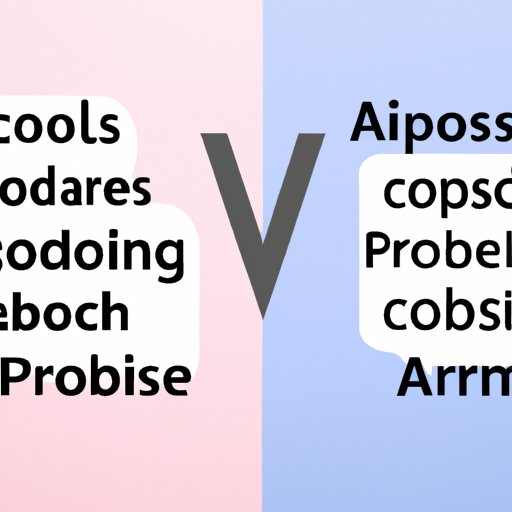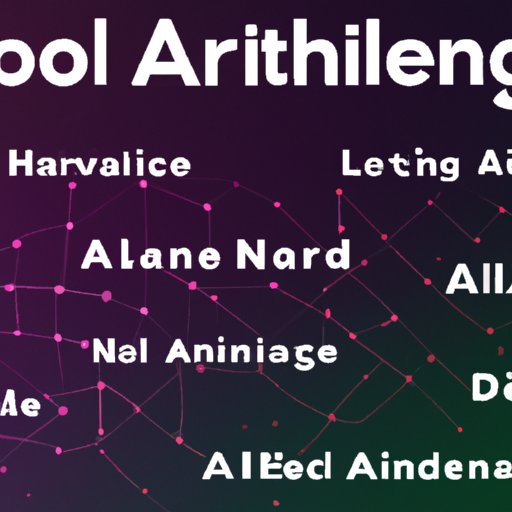Introduction
Artificial intelligence (AI) is a rapidly growing field of technology that enables computers to learn and perform tasks traditionally done by humans. AI has become an important part of many industries, from healthcare to finance to manufacturing. As such, there is an increasing demand for developers who know how to create and maintain AI systems.
The programming language used to develop AI systems varies depending on the type of application being created. Different languages have different strengths and weaknesses, so it can be difficult to determine which language is best for a particular project. In this article, we will explore the most popular AI coding languages and compare their pros and cons.
Comparing the Popular AI Programming Languages
The most popular programming languages for AI development are Python, Java, C++, R, and Lisp. Each language has its own advantages and disadvantages when it comes to developing AI systems.
Python
Python is one of the most popular programming languages for AI development. It is an open-source language with a simple syntax, making it easy to learn and use. Additionally, it has a rich library of modules and packages that can be used to quickly build AI applications.
Java
Java is another popular language for AI development. It is an object-oriented language, meaning that it focuses on creating objects rather than functions. This makes it easier to write reusable code, which is important for AI projects. Additionally, Java has a large community of developers, so getting help or finding resources is relatively easy.
C++
C++ is a powerful language for AI development. It is fast and efficient, making it ideal for complex AI projects. Additionally, it has a low level of abstraction, meaning that it allows developers to access the hardware directly, which can be useful for certain types of AI applications.
R
R is a statistical programming language designed for data analysis. It is popular among AI developers because it is well-suited for building machine learning models. Additionally, it has a wide variety of libraries and packages that can be used to quickly build AI applications.
Lisp
Lisp is an old programming language that is still used for AI development. It is a functional language, meaning that it focuses on computing results rather than performing actions. This makes it ideal for AI projects that require complex calculations and decision-making processes.

Pros and Cons of the Most Used AI Coding Languages
Each of the popular AI coding languages has its own advantages and disadvantages. We’ll explore the pros and cons of Python, Java, C++, R, and Lisp in more detail.
Python
Pros: Python is an easy-to-learn language with a simple syntax. Additionally, it has a rich library of modules and packages, making it easy to quickly build AI applications. Finally, it has a large community of developers, so it is easy to get help or find resources.
Cons: Python is not as fast or efficient as some other languages, making it less suitable for complex AI projects. Additionally, its dynamic typing system can lead to errors that are difficult to debug.
Java
Pros: Java is an object-oriented language, making it easier to write reusable code. Additionally, it has a large community of developers, so it is easy to get help or find resources. Finally, it is platform-independent, meaning that applications written in Java can be run on any operating system.
Cons: Java is not as efficient as some other languages, making it less suitable for complex AI projects. Additionally, its verbose syntax can make it difficult to read and understand.
C++
Pros: C++ is a powerful language for AI development. It is fast and efficient, making it ideal for complex AI projects. Additionally, it has a low level of abstraction, allowing developers to access the hardware directly.
Cons: C++ is a difficult language to learn, making it less suitable for beginners. Additionally, its lack of standardization can lead to compatibility issues between different versions of the language.
R
Pros: R is well-suited for building machine learning models. Additionally, it has a wide variety of libraries and packages that can be used to quickly build AI applications. Finally, it is free and open-source, making it accessible to everyone.
Cons: R is not as fast or efficient as some other languages, making it less suitable for complex AI projects. Additionally, its syntax can be difficult to understand for beginners.
Lisp
Pros: Lisp is a functional language, making it ideal for AI projects that require complex calculations and decision-making processes. Additionally, it has a powerful macro system, allowing developers to quickly create custom features.
Cons: Lisp is an old language, so it lacks many modern features and libraries. Additionally, its syntax can be difficult to understand for beginners.

Exploring the Benefits of Each Language for AI Development
When it comes to AI development, each language has its own unique benefits. Here is a quick overview of the benefits of Python, Java, C++, R, and Lisp for AI development.
Python
Python is an easy-to-learn language with a simple syntax. Additionally, it has a rich library of modules and packages, making it easy to quickly build AI applications. Finally, it has a large community of developers, so it is easy to get help or find resources.
Java
Java is an object-oriented language, making it easier to write reusable code. Additionally, it has a large community of developers, so it is easy to get help or find resources. Finally, it is platform-independent, meaning that applications written in Java can be run on any operating system.
C++
C++ is a powerful language for AI development. It is fast and efficient, making it ideal for complex AI projects. Additionally, it has a low level of abstraction, allowing developers to access the hardware directly.
R
R is well-suited for building machine learning models. Additionally, it has a wide variety of libraries and packages that can be used to quickly build AI applications. Finally, it is free and open-source, making it accessible to everyone.
Lisp
Lisp is a functional language, making it ideal for AI projects that require complex calculations and decision-making processes. Additionally, it has a powerful macro system, allowing developers to quickly create custom features.
A Comprehensive Guide to Choosing the Best AI Coding Language
Choosing the best AI coding language for a project can be a daunting task. To make the process easier, here are a few tips for choosing the right language for your project.
Understanding Your Goals
Before deciding on a language, it is important to understand the goals of the project. Different languages are better suited for different types of projects. For example, Python is a good choice for projects that require rapid prototyping, while C++ is better suited for complex AI projects.
Considering Your Existing Skillset
If you already have experience with a particular language, it may be beneficial to use that language for your AI project. However, if you are new to programming, it may be worth learning a new language that is better suited for AI development.
Evaluating the Pros and Cons of Each Language
It is important to evaluate the pros and cons of each language before making a decision. Consider the strengths and weaknesses of each language and decide which one is best for your project.

An Overview of the Best Coding Languages for AI Projects
Based on the criteria discussed above, Python, Java, C++, R, and Lisp are all good choices for AI development. Each language has its own advantages and disadvantages, so it is important to consider your project’s goals and existing skillset before making a decision.
Conclusion
Choosing the best coding language for an AI project can be a difficult task. However, by understanding the goals of the project, considering your existing skillset, and evaluating the pros and cons of each language, you can make an informed decision about which language is best for your project.
(Note: Is this article not meeting your expectations? Do you have knowledge or insights to share? Unlock new opportunities and expand your reach by joining our authors team. Click Registration to join us and share your expertise with our readers.)
